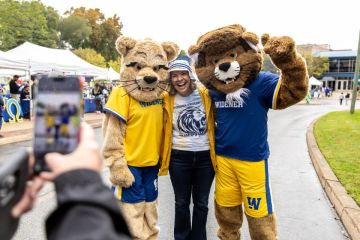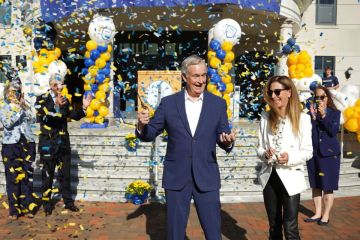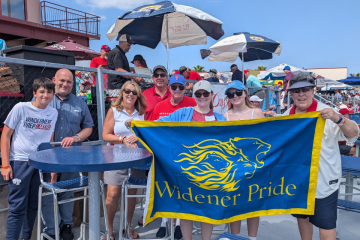What’s in a Name? History, Legacy, and Innovation

Larry Buck arrived on campus in fall 1971, hired to teach history at PMC Colleges.
That was the collective, somewhat novel, and admittedly confusing name for a bilateral institution comprised of a military school – called Pennsylvania Military College for the previous seven decades – and the newer, civilian branch, Penn Morton College.
By the end of Buck’s first academic year, the campus would bear a new name – Widener College – and a new, civilian-only mission, though it would retain its ROTC program.
“I came in thinking I’m going to teach at a relatively traditional institution. I had not counted on walking into a firestorm of innovation,” said Buck, who would remain with Widener for decades, serving as professor, provost, and acting president.
Over time, Buck watched as the school shifted its approach, with new academic majors and graduate programs, the rise of new buildings, an influx of more diverse students, and, by 1979, university status.
Widener is marking 50 years since it transitioned from a military college to a civilian one. It was a radical transformation, but one that proved inevitable.
The school was in trouble – facing declining enrollment, led in part by anti-military sentiment surrounding the Vietnam War, and the financial crisis that a smaller student body presents. Administrators believed the choice was clear: change or close.
The decision did not sit well with some cadets and alumni. The institution, which dates back to 1821, adopted military instruction beginning in the 1850s and had graduated generations of individuals who would fight in every war in which the United States took part.
The loss of military culture and tradition on campus was profoundly felt.
“It was a tidal wave pushing further away… and you realize it will never be that way again,” said James VanSciver ’72, a member of the last cadet class.
While 1972 marks a major shift in the school’s trajectory, in hindsight, it’s another chapter in the institution’s long history of adapting and responding to the changing needs of its students, the marketplace, and society.
And while the school carried a new name and mission, it remained committed to educating and developing leaders, whether in the military ranks, the corporate boardrooms, or in communities locally and globally.
“We have that rich background. The school prepared its students to not only go into battle but to make the hard decisions and assume leadership roles,” said the late Dr. J. Joseph Edgette, emeritus professor and folklorist, and unofficial historian of the school and Widener family. “We are where we are today because of where we have come from. If you miss the building blocks, you don’t fully appreciate it.”
Writing on the Wall
For many, the writing was on the wall that a military college, even one split with a civilian school, was unsustainable.
“It was clear to faculty that it was more and more difficult to recruit a sizeable, high-quality cadet corps because of anti-military feelings across the nation,” said Buck.
That anti-military feeling was felt by VanSciver when his PMC baseball and football teams played other schools. Opposing players would wear black armbands to protest the PMC’ers and their military ties.
VanSciver never felt anti-military sentiment on campus, recalling that students – cadet and civilian alike – mingled freely. “My fraternity had an equal number of cadets and civilians,” he said.
The overall size of the cadet corps was an issue as early as the mid-20th century, and new admissions policies were adopted to appeal to new and different student demographics. In 1946, the first non-cadet students arrived – World War II veterans who enrolled as commuter or boarding students. They were followed by non-residential cadets.
The school also began admitting residential and non-residential civilian students, and saw a more diverse student body, with an increase in students of color and women; the latter group first arriving in 1966 as part of a nursing program. An evening division was also added.
Read more about 50 years of Widener women's sports
When Phil Lewis ’72 first arrived on campus, he was one of only a handful of Black students. But the numbers rose, and during his time “a bunch of guys wanted to talk about forming a Black Student Union,” which happened in 1969. The BSU at Widener is still active today.
Yearbooks from this era show some of the changes underway. Interspersed among the few photos of female students are those of clean-cut cadets in military uniform, right beside civilian students sporting longer, contemporary hairstyles.
“It wasn’t like someone turned on a light and there was Widener College and the corps was out of business. It was a progression,” said Bob Moll, son of the late Clarence Moll, who led the school from 1959 to 1981.
Following the decision to disband the corps, younger cadets from the classes of 1973 to 1975 transitioned to the ROTC program to complete training, became civilian students, or left.
Moll recalls the animosity directed at his father, the school’s first civilian president. “I know it really affected both of my parents. My father was devoted to that school. To his dying day, it was the primary thing for him. I think he saved the school.”
Switching to a civilian college was not enough; the school desperately needed money. Trustee Fitz Eugene Dixon Jr., and his family, the Wideners, provided it.
The Wideners were a prominent Philadelphia family whose philanthropy helped shape the region’s educational and cultural landscape. Dixon approached his mother, Eleanor Widener (whose father and brother had perished on the Titanic), for a financial contribution, which helped keep the school going.
Grateful for his intervention, officials honored Dixon’s request to rename the school in honor of the Wideners.
A New Era
Under the Widener College banner, the school began unveiling new initiatives. Buck recalls the strong focus on faculty involvement in curriculum development and the emergence of the teacher-scholar model, with professors focused on staying current in their fields while also serving as mentors to students.
That model is a hallmark of today’s Widener.
“Any faculty apprehension was quickly replaced with frenetic activity,” recalls Buck. “In the mid-to-late 1970s, and by the 1980s, we saw ourselves as an institution that generated programs to serve the needs of the community as those needs evolved. Innovation was key to our financial success. Be very nimble, light on your feet, and offer high-quality programs.”
Recognizing the particular needs of mothers wanting to pursue higher education, Widener created evening classes to accommodate them. A shortage of quality health care administrators in the 1980s and 1990s led to an MBA program for hospital personnel to pursue part time. A dearth of qualified school principals and superintendents in the 1990s led to the creation of flexible programs to help educators achieve those positions.
That same kind of agility is employed today, as university leaders assess student desires and marketplace trends to develop new programs.
For example, the university has been unveiling new programs focusing on health care, including occupational therapy, speech-language pathology, physician assistant studies, nutrition, and flexible nursing options.
“Widener’s greatest asset has always been its ability to change while staying true to its core educational mission,” said Provost Andrew Workman. “As we once again face a challenging time for higher education, the faculty, staff, and leadership are building on the tradition of bold action like those taken in the 1970s to make sure that the university stays strong for years to come.”
Continuing the Legacy
Although 1972 remains a pivotal moment in the school’s modern history, the legacy of those earlier years endures, threaded to present day through a focus on leadership development.
Leadership at Widener takes many forms, including preparing students to be leaders in their professions, in their communities, and in service to others. The Widener Leadership Institute offers programs for undergraduate and graduate students to cultivate such skills.
Widener continues a strong connection to the service of the country through its Army ROTC cadre, Dauntless Battalion, a program helping produce the next generation of military leaders.
“Today, it’s one of the finest ROTC programs you will find and that’s attributed to a very long tradition at the institution. And it’s always headed by outstanding military people,” said Edgette.
The university continues to honor its military heritage through the PMC Museum, ongoing traditions, and alumni events. The last classes of cadets also remain committed to keeping that history alive.
“We are steadfast in trying to make sure that Widener does not lose that portion of its history,” said VanSciver.
An enduring legacy of 1972 is the continued focus on agility and relevancy.
“The leadership has been sensitive to the needs of students and career directions, and adjusted accordingly,” said Beth Sidner Kalemkarian ’74, one of the early group of female students on campus. “The institution was always looking for ways to protect the future of the school and assure its sustainability.”
Lewis views the school’s willingness to change for the better as the real legacy of 1972. “Nothing from the past,” he said, “should get us so weighed down that we don’t recognize what has to happen in the present to blossom into the future.”
It’s a sentiment echoed by Edgette.
“The most important point to that whole transitionary period was the tremendous success of raising the academic integrity of the institution,” said Edgette. “Widener University has an excellent academic reputation. That all grew out of that growth and willingness to take a chance to improve what they already had and expand on it.”
***
Editor’s Note: Dr. J. Joseph Edgette passed away shortly following the interview for this story. He was a beloved member of the Widener community and a renowned educator, scholar, and historian. The university is grateful for his invaluable contributions to the sharing of our history.









